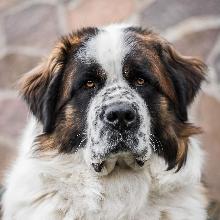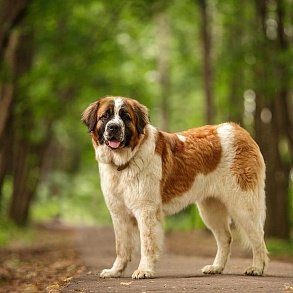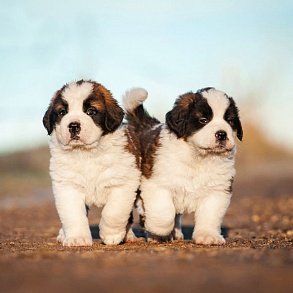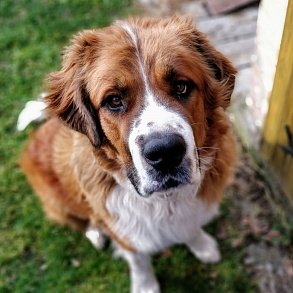Moscow Watchdog

Brief information
- Breed name: Moscow Watchdog
- Country of Origin: Russia
- Time of origin of the breed: mid-XX century
- Weight: males 55-65 kg, females 45-55 kg
- Height (height at the withers): males 65-78 cm, females 70-75 cm
- Life expectancy: 9-12 years
Highlights
- Having a developed protective and protective instinct, "Muscovites" nevertheless do not start with a half-turn, which is very different from their closest relatives – Caucasian shepherds.
- Moscow guard dogs feel good in families. Children and pets do not annoy them.
- The distinctive character traits of the Moscow watchdog are slight stubbornness and a tendency to dominance, so an adult mentor should be engaged in training the animal.
- The Moscow watchtower is not included in the list of the most pop breeds of our time, which will be especially pleasant for those who appreciate originality in everything and are looking for an unusual four-legged friend for themselves.
- An animal of such an outstanding complexion will be uncomfortable in a typical apartment, although a properly educated Moscow watchdog will do everything possible to occupy as little space as possible and not annoy the owner with its own awkwardness.
- Moscow watchdog is a working, unpretentious dog. She copes relatively well with loneliness, does not take offense at any occasion and easily adapts even to not the most favorable weather conditions.
- The maintenance of the breed is not cheap already because such a large-sized dog requires many times more feed than any shepherd dog. Accordingly, if you need a little-toothed pet, give up the dream of the Moscow watchtower.
Moscow Guard Dogs - professional security guards, self-sufficient leaders and fearless defenders, capable of putting an attacker to flight with just one look. Serious and incorruptible, they will never leave their official post and will guard the object entrusted to them to the last. At the same time, in an informal setting, "Muscovites" easily transform into calm, unassuming pets who can get along with children and willingly join in any game.
Breed characteristics
History of the Moscow Watchdog breed
The breed owes its birth to the Soviet kennel "Krasnaya Zvezda" and the acute shortage of dog personnel caused by the Second World War. At the end of the 40s, the leadership of the military dog breeding school received a state order to breed a dog that would combine the features of a guard and a defender and could serve in extreme climatic conditions. Despite the fact that the breeding base of the nursery at that time was extremely small and consisted mainly of captured animals exported from Germany, Soviet breeders managed to accomplish almost the impossible. In just a few years, the kennel managed to bring out and present to domestic dog handlers not one, but as many as four breeds, including the Moscow guard dog.
Initially, several dog families, including Russian piebald hounds, participated in the experiment to create an ideal service dog, eastern European shepherds and St. bernards . Well, the final touch to the development of the exterior and temperament of the Moscow guard dog was made caucasian shepherds . The offspring obtained from the above-mentioned breeds were crossed with them in order for them to inherit the natural aggression of their parent.
The first "Muscovites" appeared at the exhibition already in 1950. Six animals – Joy, Despot, Don, Marvelous, Dido and Ducat – were littermates and turned out to be quite capable dogs, although not devoid of external defects. In 1958, a separate standard of appearance was approved for the wards of the "Red Star", but until 1985 the breed in the USSR continued to remain officially unrecognized. As for foreign cynological associations, the Moscow watchdogs are still dark horses for them. For this reason, it is possible to meet "Muscovites" nowadays except in the CIS and occasionally in the Czech Republic and Poland, where single breeders are engaged in the breed.
Interesting fact: the colorful appearance of the Moscow watchdogs is the merit of Orslan, a male who was born in the 60s and is considered the ancestor of the breed. The first "Muscovites" who took part in exhibitions in the 50s did not look so impressive.
Video: Moscow Watchdog
Appearance of the Moscow guard dog
A formidable giant with the muzzle of a St. Bernard and the shagginess of a "Caucasian" – this is about the impression the Moscow watchtower makes on first acquaintance. By the way, despite the deceptive similarity of the Moscow watchtower and the "Alpine rescuers", there are also quite significant differences between them. In particular, the wards of the "Red Star", although they are considered giants among their own kind, are somewhat inferior in size to the "Swiss". The minimum permissible weight for an adult male of the Moscow watchdog is 55 kg, for a St. Bernard – 70 kg. The skull of the MC is much narrower than that of its Alpine relative, and the transition from forehead to muzzle is relatively smoothed. In addition, Muscovites are distinguished by a stronger constitution and an elongated body, complemented by an amazing lightness and agility of movements for such giants.
Head
Large, cheekboned, with a moderately convex, broad forehead crossed by a longitudinal groove. The muzzle of the Moscow watchdog is blunt and voluminous, noticeably shorter in length than the skull. The subglacial region is normally filled, the brow arches and occipital protuberance are clearly pronounced.
Lips
The "Muscovites" have fleshy lips of a rich black color, without wings.
Jaws and teeth
The jaws of the Moscow watchdog are massive, with a scissor bite. White teeth in the amount of 42 pieces fit snugly together. The incisors are arranged in one line. The absence of several teeth, provided that they were broken or knocked out, is not considered a defect.
Nose
The purebred Moscow watchdog has a black lobe, very large and noticeably elongated in width.
Eyes
Deep-set, small eyes tightly covered with black eyelids. The standard shade of the iris of the Moscow watchdog is black.
Ears
The correct shape of the ear is triangular, with a gently rounded tip, placed above the level of the dog's eyes. Cartilage supports the ear blade in a hanging position, so that the front edge of the ear touches the zygomatic zone.
Neck
The neck of the Moscow watchdog is muscular, of medium length, with a well-developed nape and moderate suspension. The latter may be absent in individual individuals, which is not considered a disadvantage.
Housing
Unlike the St. Bernards, the Moscow watchdogs can boast of a more stretched type of hull. The withers of the "Muscovites" are high and especially striking in males. The back is strong, of good width, with a short loin and a voluminous, slightly sloping croup. The chest of MS is deep, with convex hoops of ribs extending in the direction of the croup. The lower abdominal line is slightly tightened.
Limbs
The "Muscovites" have straight, parallel legs. The shoulder blades are of sufficient length, stand obliquely, the shoulders are well muscled. The thighs of the representatives of this breed have the same length as the shins. The dog's paws are massive; the front ones are rounded, with thick elastic pads, the rear outlines are more like an oval. The thumbs of the animals are removed.
Tail
The tail of the Moscow watchtower continues the croup line and is distinguished by a decent thickness. In a relaxed animal, the tail falls down, forming a small bend in the tip area, in an excited animal, it takes the shape of a crescent and rises above the back.
Wool
The wool of the Moscow watchdog is abundant, double, consisting of a guard hair and the thickest undercoat. The most stylish appearance is distinguished by males, whose adorning wool forms a spectacular collar on the neck and flirtatious feathering on the back of the legs. The bitches of the Moscow guard "outfit" is many times more modest because of the smaller amount of toilet hair.
Color
White with red, red-black, black-red or sable spots. Colors in which there is no red shade in any of the listed variations are considered as non-standard. In addition, the dog's chest, tail tip and paws should remain white (front – up to the elbow joint, rear – up to the shins). The head of the Moscow watchdog is framed by a black "mask", complemented by the same "glasses". The ears of representatives of this breed are also black.
Disadvantages and possible defects of the breed
Disadvantages, having which the animal will not receive a mark above "good" at the exhibition, are considered:
- excessively long neck with too much suspension;
- ears in a half-standing position;
- short, coiled or hooked tail;
- shoulder blades too short;
- a narrow head with an excessively smoothed or, conversely, a sharp stop;
- saggy, karma-like lips;
- very light color of the iris, obliquely set eyes;
- insufficiently wide set of legs;
- closeness of the hock joints;
- curly and curly hair (light wave is acceptable);
- square format housing;
- asymmetrical muzzle color;
- insufficient height.
Moscow watchmen with the following physical and mental disabilities are subject to complete disqualification:
- nervousness, cowardice;
- congenital incompleteness (broken and knocked-out teeth do not count);
- amble;
- brown color of eyelids and lobes;
- distorted jaw;
- malocclusion;
- raznoglazie.
Dogs with dewclaws, cryptorchidism and unbalanced, unscrewed movements are also rejected.
Photo of the Moscow guard dog
The character of the Moscow Watchdog
The calculation of the specialists of the "Red Star" that their pets will inherit the aggression and impulsiveness of Caucasian wolfhounds was only partially justified. Yes, the Moscow watchmen are brave and courageous, but by no means malicious and certainly not reckless. The dog will come into conflict with anyone only when the opponent clearly demonstrates his own intentions. And yet the character of the Moscow watchdog is largely determined by genes. In particular, individuals with the predominant blood of "Caucasians" show great suspicion and ferocity. They are easy-going and much more suitable for the role of fearless bodyguards. Dogs that have inherited the temperament of a St. Bernard are noticeably more phlegmatic, so such Moscow watchdogs are more often recommended for the role of family pets and keepers of household wealth.
Moscow watchmen are not talkative and only give voice if necessary. If your shaggy giant grumbled, then he really got it. In the family, the dog behaves quite peaceably: it affects the innate ability of "Muscovites" to get attached to people with whom they have to share a common territory. There is also no friction with the children of the Moscow watchtower, however, provided that these are not accidentally run-in neighbor kids. A properly educated animal will look at such guests at least indifferently, or even with outright discontent.
On the Internet, you can find a lot of video evidence that Moscow watchdogs turn out to be hyper-responsible nannies. But in reality, not everything is so clear. Of course, "Moskvich" will be happy to ride your heirs on a sled, play catch-up with them and even try to forgive them minor pranks, but it's still not worth going away for a long time and leaving stupid kids for such a giant. As an example: a random flick of the tail of this shaggy security is able to knock a three-year-old minx off his feet.
Moscow watchdogs treat each family member equally evenly. They do not divide the household into pets and episodic characters and try to listen to each of them. But this does not mean that MS is not able to guess who exactly is in charge of the house. Quite the contrary – a pet living in a family is always aware of who has the last word.
Education and training
A guard dog is a test of the owner's coaching and leadership qualities for strength. Even the most balanced and obedient "Muscovites" are not averse to playing alpha males and wiping their paws on the master's authority. So from the very first days of the young shaggy man's stay in your house, approve a system of permits and strict prohibitions and do not deviate from the set course until the pet grows up.
Moscow watchdogs usually begin to show character at the age of 6 months. In particular, teenagers may purposely not respond to the call to food or grumble and snap in response to the command. In such cases, the method that is often used by the mothers of puppies themselves will be effective. The disobedient violator of discipline is knocked off his feet, tipped over on his side and forcibly held in a supine position until he properly reflects on his own behavior and calms down.
In no case do not show the grown-up puppy that his massive jaws frighten you. Moscow watchdogs are smart enough and will quickly realize that they have "outgrown" your authority. Teasing and provoking a dog, trying to cultivate watchdog skills in it, is also not the best technique. If you regularly make attempts to take away a toy or food from MS, prepare for such anti-bites as anger and nervousness.
There are also subtleties in the use of commands. So, for example, the call "To me!" is not used for cases when the trainer is going to punish the pet. Not a single dog will voluntarily approach for the "distribution of gingerbread", and even more so the Moscow watchdog. The ban "Fu!" is pronounced in a categorical, threatening tone, so that the "Muscovite" does not have a desire to test the patience of the owner. Owners who are raising a future participant of exhibitions will need the commands "Show your teeth!" and "Nearby!".
It is worth thinking about visiting a dog of the ZKS course if you see a future bodyguard in your pet. If the candidacy of the Moscow watchdog is considered for the place of a family friend or a guard, you can limit yourself to home training. However, it should be done by an adult with a strong character who has an idea of the psyche and temperament of the breed.
Maintenance and care
The impressive complexion of the Moscow watchdogs makes them not the most comfortable pets for apartment owners, although some dog owners make such sacrifices. The optimal housing for shaggy giants will be a spacious cottage or a specially equipped aviary in the courtyard of a private house. Having warm double-layer "fur coats" MS are well adapted to Russian winters and are quite capable of surviving them in a wooden insulated booth. Usually a dog's "hut" is arranged in such a way that the animal has a good overview of the territory. If it is planned to be kept in an aviary, then the latter should be provided with a roof under which the dog will hide from the heat and bad weather.
Separately, it is worth mentioning about breeding bitches. Aviaries for expectant mothers must be built with a margin, since the Moscow watchdog is a prolific breed. In addition, it will be necessary to equip a puppy house, which will be both a "maternity hospital" and a "kindergarten" for future offspring. If the pet lives in a cottage or apartment, find a secluded, bright, protected from drafts and direct sunlight corner for his couch.
Hygiene
Having settled the Moscow watchdog in a house or apartment, stock up on combs, combs and furminator, because twice a year the dog will shed. You do not need to have superintuition to guess that there will be a lot of wool from this breed (dimensions oblige), therefore, from the first months of life, accustom puppies to daily combing. A properly educated baby should not shy away at the sight of a brush and a fluff or grumble at the owner with displeasure.
In the period between molts, "Muscovites" are also combed daily, since their wool often falls off. If there is an acute shortage of time, it is not forbidden to skip the procedure, unless, of course, the dog's "fur coat" is in a neglected state, and twigs, leaves and other debris are not entangled in it after a walk. Do not get carried away with too frequent bathing of a pet if he lives in the yard. 3-4 bath days a year is enough. Apartment dwellers are washed more often, which is due, rather, to the owner's desire to keep the house clean than necessity.
Once a week, the Moscow watchdog's ears are examined and cleaned with a damp cloth or napkin. If traces of nitrous oxide are found in the dog's eyes, they can be removed with a soft cloth soaked in a cooled tea infusion. It is better to cut the claws of Moscow watchmen as needed (usually 1 time a month), but this is an option for animals with a low level of motor activity. In MS, which are well and a lot of walking, the claw plate is worn off naturally.
Walking
The clumsiness and heaviness of the Moscow watchmen is apparent. In fact, representatives of this breed are much more active than their St. Bernard ancestors, so putting them in an aviary and enjoying a quiet life, alas, will not work. Especially the owners of apartment individuals who suffer most from physical inactivity will have to strain themselves. You will have to walk such "Muscovites" at least 4 hours a day, interspersing the usual promenades with active games. Two one and a half hour walks a day will be enough for the aviary inhabitants, but this is provided that the animal moves freely around the territory of the aviary or infield. Keeping the Moscow watchdog on a chain is considered unacceptable.
Important: Moscow watchdog puppies are allowed to walk only after two complex vaccinations. Up to a year, the baby is not loaded with long hiking and energy-consuming games, thus giving the joints of the pet to get stronger.
Feeding
The standard menu of the Moscow watchtower is lean meat or its trimmings, offal, porridge (buckwheat, rice, oatmeal, millet) and vegetables. Fermented milk and sea fish such as navagi and cod should also be present in the dog's diet. It is useful to start introducing two-month-old puppies to the taste of vegetables. For this purpose, pumpkin, cabbage, zucchini, tomatoes, potatoes and beets are suitable, which are given to babies in a slightly subdued form with the addition of unrefined vegetable oil. By the way, puppies of the Moscow guard dog are prone to food allergies, so each new product is introduced into the baby's diet very carefully and in small doses.
It is worth avoiding:
- mushrooms;
- beans, peas and any other legumes;
- chocolate, sweets and confectionery;
- pasta and baking;
- chicken bones;
- river fish;
- spicy, spicy and salty dishes.
Moscow guard dogs that consume only natural food should be additionally given vitamin and mineral complexes and top dressing with chondroitin and glucosamine, which are indispensable for joints. If you plan to keep a four-legged friend on industrial "drying", choose varieties designed specifically for giant breeds, and these should not be economy-class feeds.
Health and diseases of Moscow guard dogs
The scourge of all dogs of large breeds – hip dysplasia – has not bypassed the Moscow watchdogs. The disease is almost always caused genetically and often manifests itself after 4 or more generations, so it is extremely difficult to predict the possibility of its occurrence in puppies even from X-rays. And yet, despite the fact that it is impossible to completely overcome this unpleasant diagnosis, it is quite possible to teach a pet to live with it. The main thing is not to limit the animal in moderate motor activity and not to allow it to gain excess weight. By the way, about weight indicators: "Muscovites" who are fed, not in accordance with the established norms, and are treated to sweets without measure, swim fat in a matter of months. You can fight the problem with the same physical exertion and a therapeutic diet. But the predisposition of the breed to allergies is not treated from the word at all, although veterinarians do not prohibit suppressing outbreaks of the disease with antihistamines.
How to choose a puppy
- The optimal age for moving a Moscow watchdog puppy to your house is 7 weeks, but it's better to get to know your pet early in order to be able to track its development, as well as changes in behavior and character.
- Visit the baby's mom and evaluate her reaction to your invasion of her territory. If a bitch demonstrates shyness and cowardice, most likely the offspring will also inherit these qualities.
- Leaders grow out of brisk, contact puppies, who, with proper training, turn into harsh bodyguards. Those who do not plan to acquire a shaggy dominant, it is better to look at more modest and soft babies, which make good family pets and responsible property keepers.
- Don't grab the biggest puppy from the litter. Heavy weight is an extra load on the ligaments and joints, which are already not the strongest among the Moscow guards. The optimal weight of a monthly puppy is 3.5 kg (if the litter is large) or 4.5 kg (in a small litter).
- Examine the pet's belly. It should be moderately warm, elastic and without traces of umbilical hernia.
- Ask the breeder how many brothers and sisters your puppy had initially. It's great if the bitch has 6 or less "tails". If there were more babies, they probably didn't have enough mother's milk.
Photos of puppies of the Moscow guard dog
How much does the Moscow watchtower cost
The cost of an animal is determined by its class, the purity of the pedigree and the championship titles of the parents. In accordance with these parameters, a Moscow watchdog puppy can cost both $150 rubles and $300. An option for lovers of risk and unhealthy economy is dogs without pedigree and mestizos. Such "pseudo-Muscovites" cost on average from $50 to $70 and are often very different from the average Moscow watchdog.


